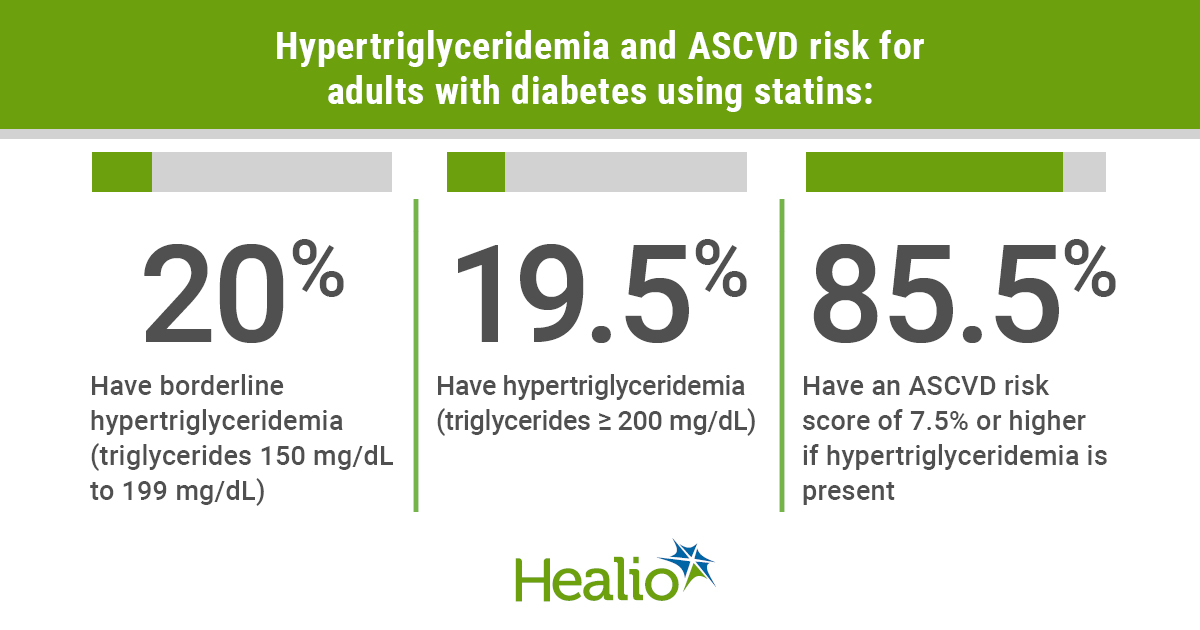Hypertriglyceridemia affects nearly 20% of adults with diabetes despite statin use
Among a cohort of adults with diabetes, 20% had hypertriglyceridemia — including 19.5% of those using statins — and this condition may confer greater atherosclerotic cardiovascular disease risk, according to findings published in Diabetes Care.

“Despite statin use, nearly 40% of US adults with diabetes have borderline high or high triglycerides, and approximately 40% of these persons are at high (≥ 20%) risk of a cardiovascular event in the next 10 years,” Nathan D. Wong, PhD, MPH, professor and director of the Heart Disease Prevention Program in the division of cardiology at the University of California, Irvine, told Endocrine Today. “These data are important since they identify a substantial number of adults, who despite being on statins, still have substantial ASCVD risk that may, at least in part, be related to their suboptimal triglyceride levels.”
Wong and colleagues analyzed data from the 2007-2014 National Health and Nutrition Examination Survey to assess total cholesterol, HDL cholesterol, LDL cholesterol, triglycerides and statin use among 1,448 adults with diabetes (mean age, 59.8 years; 49.4% women). The researchers also calculated 10-year ASCVD risk scores.
The researchers identified borderline hypertriglyceridemia (triglycerides 150 mg/dL to 199 mg/dL) in 20.1% of the cohort and hypertriglyceridemia (triglycerides 200 mg/dL) in 22.5%. This roughly 40% rate of at least borderline hypertriglyceridemia was lower than that seen in the 2009-2010 NHANES.

For those who used statins, 20% had borderline hypertriglyceridemia, whereas 20.1% of those who did not use statins had the condition (P < .0001). In addition, among those who used statins, 19.5% had hypertriglyceridemia, whereas 25.3% of those who did not use statins had the condition (P < .0001).
Among those not using statins, hypertriglyceridemia was present in 32.2% of those of Hispanic ethnicity, 25.8% of those of non-Hispanic white ethnicity, 14.4% of those of non-Hispanic black ethnicity and 26% of those of other ethnicities (P < .01 for all). The researchers noted that differences between ethnicities did not reach statistical significance for those using statins.
Among those with hypertriglyceridemia who were using statins, 28.6% had LDL cholesterol of 160 mg/dL or more, 15.9% between 130 mg/dL and 159 mg/dL, 22% between 100 mg/dL and 129 mg/dL, 15.4% between 70 mg/dL and 99 mg/dL, and 16.7% had LDL cholesterol less than 70 mg/dL (P = .0386 for all).
Among those with hypertriglyceridemia not using statins, 39% had LDL cholesterol of 160 mg/dL or more, 31.4% between 130 mg/dL and 159 mg/dL, 9.2% between 100 mg/dL and 129 mg/dL, 23.2% between 70 mg/dL and 99 mg/dL, and 11.5% had LDL cholesterol less than 70 mg/dL (P < .0001 for all).
Among participants with hypertriglyceridemia, an ASCVD risk score of at least 7.5% was calculated for 77.5% of participants not using statins vs. 85.5% of those using statins.
The odds of a triglyceride level of at least 150 mg/dL were greater for women compared with men (OR = 1.88; 95% CI, 1.02-3.48). In addition, compared with those of non-Hispanic white ethnicity, the odds of a triglyceride level of at least 150 mg/dL were smaller for those of non-Hispanic black ethnicity (OR = 0.34; 95% CI, 0.17-0.69). The researchers also noted that for every standard deviation increase in HDL cholesterol, the odds for borderline hypertriglyceridemia were reduced by 55% (OR = 0.45; 95% CI, 0.31-0.65).
“Our results have important implications for the need for newer therapies beyond statins to help address this residual ASCVD risk,” Wong said. – by Phil Neuffer
Disclosures: The authors report this project was supported by a contract from Amarin Pharma. Wong reports he has received research support from Amarin, Amgen, Boehringer Ingelheim and Novo Nordisk and served on the speakers bureau for Amarin and Sanofi and as a consultant or on the advisory board for Amarin, AstraZeneca and Novartis. Please see the study for all other authors’ relevant financial disclosures.
